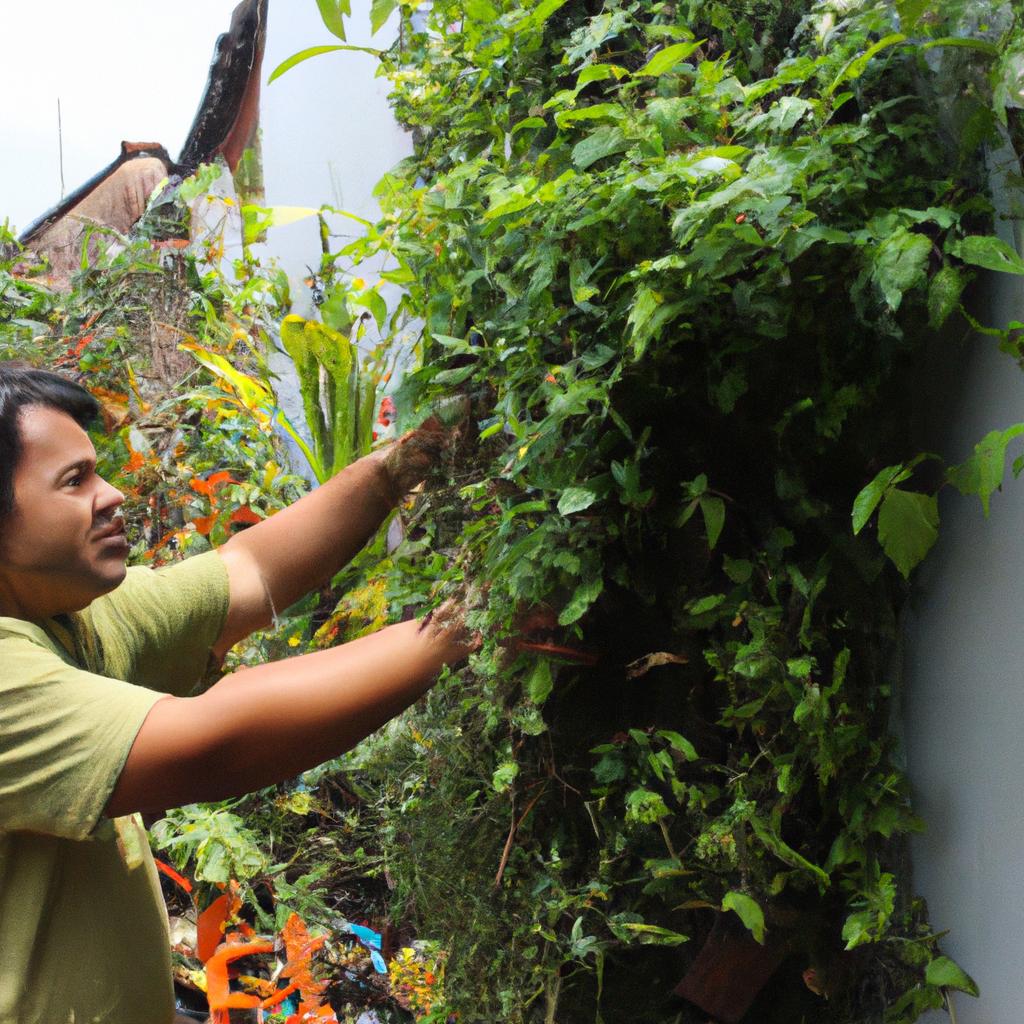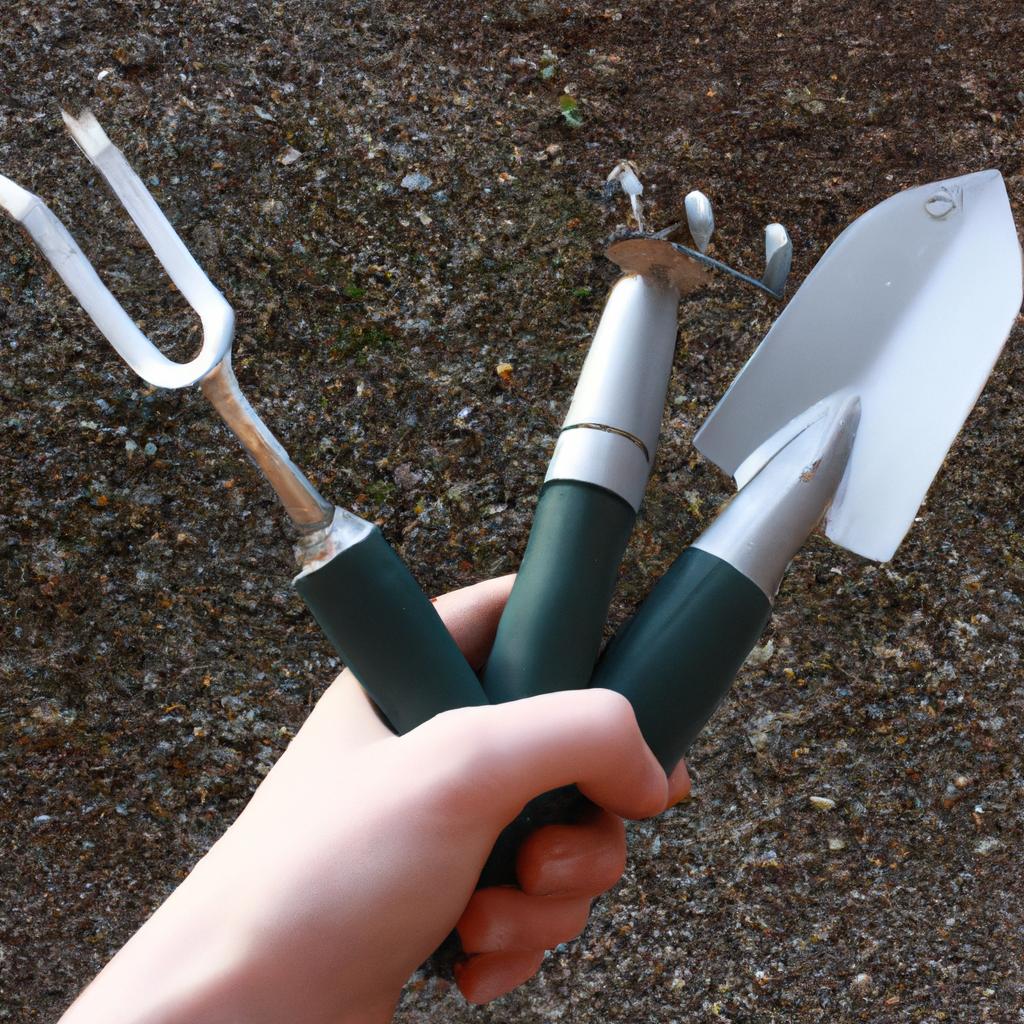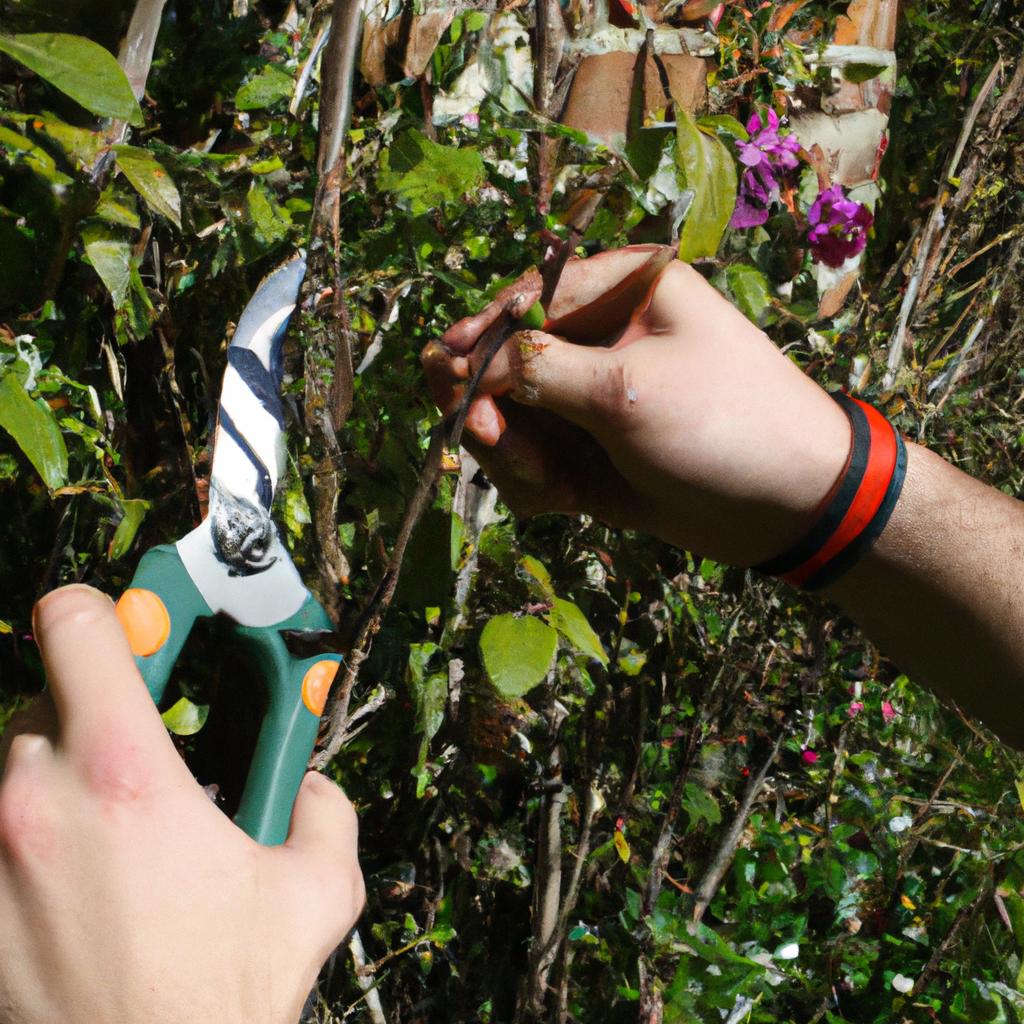Herb and vegetable gardening has long been recognized as a popular recreational activity that combines the joy of cultivating plants with the satisfaction of producing one’s own food. This article aims to explore the multifaceted benefits of herb and vegetable gardening, highlighting its potential for both physical and mental well-being, as well as its role in promoting sustainable living practices.
Imagine a small urban apartment balcony transformed into an abundant garden filled with aromatic herbs such as basil, thyme, and rosemary, alongside vibrant vegetables like tomatoes, peppers, and lettuce. This hypothetical case study illustrates how even limited spaces can be utilized creatively to engage in herb and vegetable gardening. Engaging in this form of recreation not only allows individuals to connect more intimately with their environment but also enables them to embark on a journey of self-sufficiency while exploring the diverse flavors and nutritional value offered by different plant varieties.
By engaging in herb and vegetable gardening, individuals can reap numerous health benefits. Physically, it provides an opportunity for regular exercise through activities such as digging soil beds, planting seeds or seedlings, watering plants, and harvesting produce. Mentally, it offers a therapeutic escape from the stresses of daily life as tending to plants encourages mindfulness and promotes relaxation. Additionally, consuming freshly harvested herbs can provide a boost in nutrition and flavor to meals. Herbs like basil, thyme, and rosemary are rich in antioxidants and essential nutrients that support overall well-being. Incorporating these herbs into dishes not only enhances their taste but also adds nutritional value, making herb and vegetable gardening a great way to improve one’s diet.
Furthermore, herb and vegetable gardening promotes sustainable living practices by reducing the carbon footprint associated with food production and transportation. Growing your own herbs and vegetables eliminates the need for long-distance shipping and reduces packaging waste. It also allows individuals to have control over how their plants are grown, ensuring the use of organic methods that minimize harm to the environment.
In conclusion, herb and vegetable gardening offers a range of benefits for both physical and mental health while promoting sustainable living practices. Whether you have access to a small balcony or a spacious backyard, engaging in this activity allows you to connect with nature, enhance your diet with fresh produce, exercise regularly, find relaxation through mindfulness, and contribute to a more eco-friendly lifestyle. So why not start your own herb and vegetable garden today?
Benefits of Growing Your Own Food
One example of the benefits of growing your own food is the case study of Sarah, a busy professional who decided to start her own herb and vegetable garden. Prior to starting her garden, Sarah relied heavily on store-bought produce for her meals. However, after experiencing frequent disappointments in the quality and taste of these products, she became motivated to take matters into her own hands.
There are several advantages to growing your own food that can enhance not only the quality of your meals but also your overall well-being. Firstly, homegrown fruits and vegetables have been found to be more nutritious compared to their commercially grown counterparts. Research has shown that freshly harvested produce contains higher levels of essential vitamins, minerals, and antioxidants due to minimal transportation and processing time. This means that by cultivating your own crops, you can ensure that you are consuming food at its peak nutritional value.
In addition to improved nutrition, there is an undeniable sense of satisfaction that comes with harvesting your own food from the backyard. The act itself provides a connection between individuals and nature, fostering a deeper appreciation for the environment and promoting sustainable practices. Furthermore, gardening can serve as a therapeutic activity, reducing stress levels and providing mental clarity amidst today’s fast-paced lifestyle.
- Sense of accomplishment
- Increased self-sufficiency
- Environmental consciousness
- Enhanced flavor experience
Moreover, let us explore how these benefits manifest in everyday life through this table:
| Benefit | Description | Example |
|---|---|---|
| Sense of accomplishment | Feeling proud and fulfilled when witnessing plants grow | Harvesting ripe tomatoes |
| Increased self-sufficiency | Being less dependent on grocery stores or markets for basic produce | Making a salad entirely from homegrown lettuce |
| Environmental consciousness | Contributing to sustainable practices and reducing carbon footprint | Composting kitchen scraps for fertilization |
| Enhanced flavor experience | Savoring the full, rich taste of freshly picked herbs and vegetables that cannot be replicated in store-bought alternatives | Enjoying a zesty basil pesto made from homegrown basil |
In summary, growing your own food offers numerous benefits. Not only does it allow you to enjoy more nutritious produce, but it also provides a sense of accomplishment, increases self-sufficiency, promotes environmental consciousness, and enhances the overall flavor experience. As we transition into the next section on choosing the right herbs and vegetables, let us delve further into how you can embark on this rewarding journey.
Choosing the Right Herbs and Vegetables
Imagine this scenario: you step out into your backyard, pluck a few freshly grown herbs and vegetables from your garden, and use them to create a delicious homemade meal. The aroma fills the air as you experiment with different flavors, textures, and combinations. This is just one example of how herb and vegetable gardening can open up a world of culinary possibilities for food enthusiasts.
When it comes to exploring the culinary potential of homegrown produce, there are numerous benefits that extend beyond mere convenience. Let’s delve deeper into why growing your own herbs and vegetables can be an exciting journey:
-
Enhanced Flavor: Unlike store-bought produce that often loses its taste during transportation and storage, homegrown herbs and vegetables offer unparalleled freshness. Imagine savoring a tomato that bursts with flavor or enjoying the intense aroma of fresh basil in your favorite pasta dish. By growing your own food, you have control over when to harvest, ensuring peak ripeness and optimal flavor.
-
Diversity in Ingredients: Herb and vegetable gardening empowers you to experiment with a wide range of unique ingredients that may not be readily available at your local grocery store. From exotic herbs like lemongrass or Thai basil to heirloom varieties of tomatoes or peppers, cultivating these plants allows you to explore diverse flavors from around the world.
-
Nutritional Value: Homegrown produce tends to retain higher nutritional content compared to commercially grown alternatives due to shorter transit times between harvesting and consumption. Additionally, by avoiding pesticides commonly used in conventional farming practices, you can ensure that what ends up on your plate is free from harmful chemicals.
-
Connection with Nature: Engaging in herb and vegetable gardening creates an opportunity for individuals to reconnect with nature while nurturing their green thumbs. The act of tending to plants provides a sense of mindfulness and fulfillment as you witness the growth process firsthand.
To further illustrate the vast array of options available through herb and vegetable gardening, consider the table below showcasing a variety of herbs and vegetables along with their potential culinary uses:
| Herb/Vegetable | Culinary Uses |
|---|---|
| Basil | Pesto sauces, Caprese salads, infused oils |
| Rosemary | Roasted meats, breads, marinades |
| Mint | Mojitos, teas, desserts |
| Thyme | Soups, stews, roasted vegetables |
| Cilantro | Salsas, curries, guacamole |
| Spinach | Salads, smoothies, sautéed dishes |
| Bell Peppers | Stir-fries, fajitas, stuffed peppers |
| Zucchini | Grilled vegetables, zucchini bread |
As you embark on this journey exploring the world of flavors that herb and vegetable gardening has to offer, your next step will be preparing the soil for planting. By ensuring an optimal growing environment from the start, you set yourself up for success in cultivating a thriving garden.
Preparing the Soil for Planting
Section Title: “Creating an Optimal Growing Environment”
Once you have made your selections, it’s time to create an optimal growing environment for these plants.
Creating an ideal growing environment requires attention to various factors that can significantly affect plant growth. Let’s consider a hypothetical scenario where we want to grow tomatoes in our garden. To ensure their success, we need to focus on the following:
-
Sunlight Exposure:
- Tomatoes thrive in full sunlight.
- Place them in an area where they will receive at least 6-8 hours of direct sunlight per day.
-
Soil Quality:
- The soil should be well-draining with good water retention capabilities.
- Amend the soil with organic matter such as compost or aged manure to improve its fertility and structure.
-
Temperature Range:
- Tomatoes prefer warm weather conditions.
- Ensure that the average temperature during the growing season stays between 70°F (21°C) and 80°F (27°C).
-
Adequate Spacing:
- Provide sufficient space between tomato plants for proper air circulation, preventing overcrowding and disease spread.
To better understand how these factors interact and influence plant growth, refer to the table below highlighting their relationship with tomato cultivation:
| Factors | Impact on Tomato Growth |
|---|---|
| Sunlight exposure | Directly affects photosynthesis rates; insufficient sunlight may result in weak plants and low fruit yield |
| Soil quality | Nutrient availability is essential for healthy root development and overall plant vigor |
| Temperature range | Affects metabolic processes within tomato plants; extreme heat or cold can cause stress or damage |
| Adequate spacing | Prevents competition for nutrients among neighboring plants; allows airflow to minimize disease risks |
In summary, creating an optimal growing environment for your herbs and vegetables involves understanding their specific needs. By considering factors such as sunlight exposure, soil quality, temperature range, and adequate spacing, you can provide the best conditions for healthy plant growth.
Now that we have established an ideal growing environment, let’s move on to exploring effective watering and fertilizing techniques to ensure the continued health of our plants.
Watering and Fertilizing Techniques
Section H2: Watering and Fertilizing Techniques
Having prepared the soil for planting, let us now delve into effective watering and fertilizing techniques. These essential practices are crucial in ensuring the successful growth and development of your herb and vegetable garden.
To illustrate the importance of proper watering and fertilizing, consider the hypothetical case study of two tomato plants planted side by side. Plant A receives regular watering and appropriate fertilizer application, while Plant B is neglected in terms of water supply and nutrient provision. As a result, Plant A flourishes with vibrant foliage, abundant fruit production, and overall healthy growth. In contrast, Plant B exhibits stunted growth, yellowing leaves, and sparse yield.
When it comes to watering your garden effectively:
- Monitor soil moisture regularly using a moisture meter or simply by feeling the soil’s dryness.
- Water deeply but infrequently to encourage deep root growth.
- Avoid overwatering which can lead to root rot or other fungal diseases.
- Consider drip irrigation or soaker hoses as efficient methods that deliver water directly to plant roots without wastage.
Fertilizing plays a vital role in providing essential nutrients to support optimal plant growth. Here is an example four-item bullet point list highlighting key aspects of fertilization:
- Choose organic fertilizers such as compost or well-aged manure for environmentally friendly options.
- Follow instructions on commercially available fertilizers carefully regarding dosage amounts and frequency of application.
- Apply slow-release fertilizers during initial planting phase for gradual nutrient release over time.
- Supplement with micronutrients like iron or magnesium if specific deficiencies are identified through leaf analysis or visual symptoms.
Table 1 below provides a summary comparison between synthetic chemical-based fertilizers (Conventional) versus organic alternatives (Organic), emphasizing their impact on both plants’ health and environmental sustainability:
| Conventional | Organic | |
|---|---|---|
| Plant Health | May provide quick results | Supports long-term soil fertility |
| Environmental Impact | Risk of water and air pollution | Promotes biodiversity and ecological balance |
| Soil Quality | Can degrade soil structure | Improves soil health and nutrient content |
In conclusion, adopting appropriate watering and fertilizing techniques is crucial for the successful cultivation of your herb and vegetable garden. By ensuring consistent moisture levels and providing adequate nutrients, you can create an ideal environment that promotes healthy plant growth, maximizes yield, and minimizes potential issues such as pest infestations or diseases.
With a solid foundation in watering and fertilization established, let us now explore effective pest control methods to safeguard the well-being of your thriving garden.
Effective Pest Control Methods
Imagine this scenario: You wake up one morning to find your tomato plants withering under the scorching sun. Despite your best efforts, you realize that they have not received enough water in recent days. As an aspiring herb and vegetable gardener, it is crucial to understand the importance of proper watering and fertilizing techniques to ensure the health and productivity of your crops.
To begin, let’s explore some effective watering practices. First and foremost, understanding the specific water requirements of different plants is essential. While some herbs such as rosemary or thyme prefer drier soil conditions, others like basil or parsley thrive in moist environments. By tailoring your watering routine to meet these individual needs, you can prevent overwatering or underwatering.
In addition to regular watering, providing adequate nutrients through fertilization plays a vital role in promoting plant growth. There are various organic and synthetic fertilizer options available on the market today. When choosing a fertilizer, consider factors such as nutrient composition, release rate, and overall plant requirements. Remember that excessive use of chemical fertilizers may harm both the environment and your plants’ long-term health.
Now let’s delve into four key points regarding watering and fertilizing techniques:
- Consistency: Establishing a consistent watering schedule minimizes stress on plants by maintaining optimal moisture levels.
- Mulching: Applying a layer of mulch around your plants helps retain soil moisture while suppressing weed growth.
- Compost Tea: Utilizing compost tea as a natural liquid fertilizer provides plants with essential nutrients while improving soil structure.
- Soil Testing: Conduct periodic soil tests to determine nutrient deficiencies or imbalances that might require adjustments through targeted fertilization strategies.
Embracing these principles will help optimize plant growth and yield bountiful harvests for aspiring herb and vegetable gardeners. However, successful gardening goes beyond just nourishing our green companions; we must also protect them from potential threats.
Harvesting and Storing Your Homegrown Produce
After effectively managing pests in your herb and vegetable garden, it is important to understand how to harvest and store your homegrown produce. This knowledge will ensure that you can enjoy the fruits of your labor for an extended period of time while maximizing their flavor and nutritional value.
Example:
Imagine this scenario: You step out into your backyard, armed with a basket, ready to gather the vibrant red tomatoes that have ripened on the vine. With each pluck from the plant, you feel a sense of accomplishment knowing that these tomatoes were nurtured by your own hands. As you collect them one by one, you envision all the delicious dishes they will enhance over the coming weeks.
Harvesting and storing your homegrown produce involves several key considerations:
- Timing: It is crucial to pick vegetables at their peak ripeness to ensure optimal taste and texture. Each crop has its own indicators for determining readiness; for example, ripe tomatoes should be firm yet yield slightly when gently squeezed.
- Handling: Proper handling techniques are essential in preserving the quality of your harvested produce. Avoid bruising or damaging fragile crops like berries by gently placing them in containers rather than simply dumping them in.
- Storage conditions: Different vegetables require specific storage conditions to maintain freshness. Leafy greens thrive best when stored in cool temperatures with high humidity, while root vegetables prefer cooler environments without moisture.
- Preservation methods: If you have an abundance of produce or anticipate not using it immediately, consider preserving techniques such as freezing or canning. These methods allow you to extend the lifespan of your homegrown crops beyond their natural shelf life.
To better visualize these considerations, refer to the following table highlighting recommended storage conditions for common vegetables:
| Vegetable | Optimal Storage Conditions |
|---|---|
| Tomatoes | Room temperature |
| Leafy Greens | Refrigerator, in a bag |
| Carrots | Cool and dry |
| Cucumbers | Refrigerator |
By implementing these strategies when harvesting and storing your homegrown produce, you can maximize the flavors of your crops while enjoying them for an extended period. The rewards of savoring fresh vegetables nurtured by your own hands are not only delicious but also gratifying. So venture into your garden, gather nature’s bounty, and relish in the joy of sustainable food exploration.
Please let me know if there is anything else I can assist you with!
 Refoksa
Refoksa



